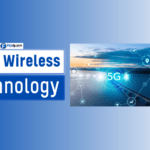Understanding RF Technology
RF Technology, or radio frequency technology, refers to the use of electromagnetic waves within the radio frequency spectrum to transmit and receive data wirelessly. The radio frequency spectrum encompasses a range of frequencies from 3 kHz to 300 GHz, each serving distinct purposes in various applications. RF technology harnesses these frequencies to enable communication, control, and sensing in numerous devices and systems.
What is RF Technology?

At its core, RF technology involves generating, transmitting, receiving, and processing electromagnetic waves to facilitate wireless communication. These waves oscillate at specific frequencies, allowing them to carry information over distances without the need for physical connections.
The versatility of RF technology makes it indispensable in modern wireless systems, from simple remote controls to complex communication networks.
Key Components of RF Systems
- Transmitter: Converts electrical signals into RF waves.
- Receiver: Captures RF waves and converts them back into electrical signals.
- Antenna: Facilitates the transmission and reception of RF waves.
- Modulator/Demodulator: Encodes and decodes information onto the RF waves.
Understanding these components is crucial to appreciating how RF technology functions and integrates into various applications.
How RF Technology Works
RF technology operates by manipulating electromagnetic waves within the radio frequency spectrum to transmit data. Here’s a simplified overview of the process:
- Signal Generation: An electrical signal containing the desired information is generated.
- Modulation: The signal is modulated onto an RF carrier wave, altering its amplitude, frequency, or phase to encode the information.
- Transmission: The modulated RF wave is transmitted through an antenna into the surrounding environment.
- Propagation: The RF waves travel through space, potentially reflecting off objects or passing through mediums.
- Reception: A receiving antenna captures the RF waves.
- Demodulation: The receiver extracts the original electrical signal from the RF wave.
- Processing: The recovered signal is processed and utilized as intended, such as audio playback or data interpretation.
This cycle enables wireless communication between devices, allowing for the exchange of information without direct physical connections.
Key Applications of RF Technology

RF technology’s versatility allows it to be employed across a broad spectrum of industries. Below are some of the most prominent applications:
Telecommunications
One of the most ubiquitous applications of RF technology is in telecommunications. RF waves facilitate wireless communication in various forms, including:
- Cellular Networks: RF technology enables mobile phones to connect to cellular towers, facilitating voice calls, text messaging, and internet access.
- Wi-Fi: Wireless internet connections in homes, offices, and public spaces rely on RF signals to transmit data between routers and devices.
- Satellite Communications: RF waves are used to transmit data between satellites and ground stations, supporting global communication networks.
Example: The 5G network, which promises higher speeds and lower latency, relies heavily on advanced RF technology to manage the increased demand for wireless data transmission.
Medical Devices
RF technology plays a critical role in the medical field, enhancing both diagnostic and therapeutic capabilities.
- Imaging Systems: MRI machines use RF pulses to generate detailed images of the body’s internal structures.
- Therapeutic Treatments: RF energy is employed in procedures like diathermy to generate deep tissue heating for pain relief and muscle relaxation.
- Wearable Health Monitors: Devices such as fitness trackers and smartwatches use RF signals to communicate health data to smartphones or cloud services.
Example: RFID (Radio-Frequency Identification) tags are used in hospitals to track medical equipment, ensuring efficient inventory management and reducing the risk of loss or theft.
Industrial Automation
In industrial settings, RF technology enhances automation and control systems, improving efficiency and safety.
- Wireless Sensors: RF-enabled sensors monitor various parameters like temperature, pressure, and humidity, transmitting data in real-time for process optimization.
- Remote Control Systems: Machinery and equipment can be controlled remotely using RF signals, reducing the need for manual intervention and minimizing operational risks.
- RFID in Supply Chain Management: RF technology is used to track products and materials throughout the supply chain, enhancing visibility and inventory management.
Example: In manufacturing plants, RF-enabled robots can communicate with central control systems to coordinate tasks, increasing productivity and reducing downtime.
Consumer Electronics
RF technology is integral to a wide array of consumer electronics, enhancing connectivity and user experience.
- Smartphones and Tablets: These devices use RF signals for cellular communication, Wi-Fi, Bluetooth, and GPS functionalities.
- Television and Radio Broadcasting: RF waves transmit audio and video content to homes and businesses.
- Smart Home Devices: Products like smart thermostats, security cameras, and smart lights use RF technology to communicate and operate efficiently.
Example: Bluetooth headphones utilize RF signals to wirelessly connect to smartphones, providing users with convenient and tangle-free audio solutions.
Automotive Industry
The automotive sector leverages RF technology to improve vehicle functionality, safety, and connectivity.
- Keyless Entry Systems: RF signals allow drivers to unlock and start their vehicles without physically inserting a key.
- Vehicle-to-Everything (V2X) Communication: RF technology enables vehicles to communicate with each other and with infrastructure, enhancing road safety and traffic management.
- Infotainment Systems: Wireless connectivity in cars allows for seamless integration of smartphones, streaming services, and navigation systems.
Example: Modern cars equipped with adaptive cruise control use RF sensors to maintain safe distances from other vehicles, enhancing driving safety and convenience.
Benefits of RF Technology

The widespread adoption of RF technology across various industries is driven by its numerous benefits, which include:
Enhanced Connectivity
RF technology enables seamless wireless communication, eliminating the need for physical cables and allowing for greater mobility and flexibility in device usage.
Cost-Effectiveness
Wireless systems often reduce installation and maintenance costs associated with cabling, making RF technology a cost-effective solution for many applications.
Scalability
RF-based systems can be easily scaled to accommodate growing demands, whether it’s expanding a wireless network or adding more devices to an industrial automation system.
Flexibility and Mobility
RF technology supports the mobility of devices, enabling users to connect and communicate from virtually anywhere within the coverage area.
Improved Efficiency
Wireless communication facilitated by RF technology can enhance operational efficiencies by enabling real-time data transmission, remote monitoring, and automated control systems.
Reliability
Advancements in RF technology have led to more reliable wireless communication, with reduced interference and improved signal integrity, ensuring consistent performance.
Safety and Convenience
In applications like automotive keyless entry systems and medical monitoring devices, RF technology enhances safety and user convenience by enabling secure and effortless operations.
Common Misconceptions and Challenges
Despite its numerous advantages, RF technology is often surrounded by misconceptions and faces certain challenges that can hinder its effective implementation.
Misconception 1: RF Technology is Harmful to Health
Clarification: Extensive research has shown that RF exposure within regulated limits is safe for humans. Regulatory bodies like the Federal Communications Commission (FCC) set stringent guidelines to ensure that RF emissions from devices do not pose health risks. However, as technology evolves, it’s worth exploring alternative methods of communication, such as Infrared Wireless Technology, which offers unique benefits and applications that may enhance safety and efficiency in various settings.
Misconception 2: RF Technology is Obsolete
Clarification: On the contrary, RF technology continues to evolve, with advancements like 5G, Internet of Things (IoT), and smart technologies relying heavily on RF innovations to enhance performance and capabilities.
Challenge 1: Interference and Signal Quality
RF signals can be susceptible to interference from other electronic devices, physical obstructions, and environmental factors, potentially impacting signal quality and reliability.
Solution: Employing advanced modulation techniques, adaptive signal processing, and proper spectrum management can mitigate interference issues and enhance signal integrity.
Challenge 2: Spectrum Allocation and Regulation
The radio frequency spectrum is a limited resource, and efficient allocation is essential to prevent congestion and ensure optimal utilization.
Solution: Implementing dynamic spectrum management and promoting spectrum sharing can help address allocation challenges, ensuring that RF resources are used effectively.
Challenge 3: Security Concerns
Wireless communication inherently poses security risks, such as unauthorized access and data interception.
Solution: Implementing robust encryption protocols, secure authentication mechanisms, and regular security updates can safeguard RF communications against potential threats.
Future Trends in RF Technology
The landscape of RF technology is continually advancing, with several emerging trends poised to shape its future applications and benefits.
1. 5G and Beyond
The rollout of 5G networks is set to revolutionize wireless communication with higher speeds, lower latency, and increased capacity. Future iterations like 6G are expected to further enhance these capabilities, enabling new applications such as augmented reality, autonomous vehicles, and smart cities.
2. Internet of Things (IoT)
RF technology is the backbone of IoT, facilitating connectivity between billions of devices. As IoT continues to expand, advancements in RF will support more efficient and scalable wireless networks, enhancing device interoperability and data management.
3. Advanced Antenna Technologies
Innovations like Massive MIMO (Multiple Input Multiple Output) and beamforming are enhancing the performance of RF systems, providing better coverage, increased data rates, and improved energy efficiency.
4. RF Energy Harvesting
RF energy harvesting involves capturing ambient RF energy to power low-energy devices, reducing the reliance on batteries and enabling sustainable and maintenance-free operations for IoT devices and sensors.
5. Enhanced Security Protocols
With the increasing reliance on wireless communication, there is a growing emphasis on developing advanced security protocols to protect RF communications from evolving cyber threats.
6. Integration with AI and Machine Learning
Integrating RF technology with artificial intelligence and machine learning can lead to smarter and more adaptive wireless systems, optimizing performance, predicting maintenance needs, and enhancing user experiences.
Conclusion
RF Technology remains a cornerstone of modern wireless communication, driving innovations across diverse sectors from telecommunications and healthcare to industrial automation and consumer electronics. Its ability to provide reliable, cost-effective, and flexible connectivity solutions makes it indispensable in today’s interconnected world.
While challenges such as interference, spectrum management, and security persist, ongoing advancements and future trends promise to address these issues, further solidifying the role of RF technology in shaping the future of technology.
As industries continue to embrace digital transformation, the applications and benefits of RF technology will only expand, unlocking new possibilities and enhancing the efficiency, safety, and convenience of our daily lives.
Understanding the fundamentals, staying informed about emerging trends, and addressing existing challenges are crucial for leveraging the full potential of RF technology in the years to come.
FAQs, RF Technology
1. What is RF Technology?
RF (Radio Frequency) technology refers to the use of electromagnetic fields to transmit and receive data wirelessly. It operates within the frequency range of 3 kHz to 300 GHz and is commonly used in various applications, including communication, broadcasting, and radar systems.
2. How does RF Technology work?
RF technology works by generating electromagnetic waves that carry information. These waves are transmitted through antennas, which convert electrical signals into radio waves. The receiving antenna captures these waves and converts them back into electrical signals for processing.
3. What are the common applications of RF Technology?
RF technology is used in various applications, including:
Wireless communication (e.g., mobile phones, Wi-Fi)
Broadcasting (e.g., radio and television)
RFID (Radio Frequency Identification) systems
Satellite communications
Radar and navigation systems
4. What are the advantages of using RF Technology?
Some advantages of RF technology include:
Wireless communication capabilities, allowing for mobility and flexibility.
The ability to transmit data over long distances.
Reduced installation costs due to the absence of wiring.
Capability to penetrate obstacles, making it effective in diverse environments.











